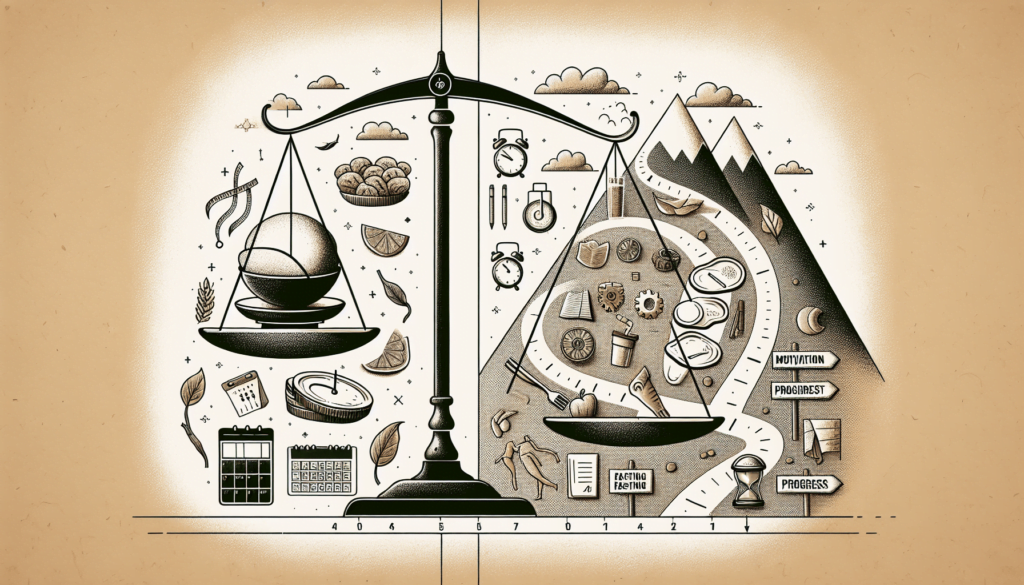You’ve been diligently fasting for weight loss, taking control of your eating habits and seeing some promising results. But recently, you’ve hit a roadblock: a weight loss plateau. It can be frustrating and demotivating, but fear not – in this article, we’ll explore effective strategies to break through those plateaus and get back on track to reaching your weight loss goals. Whether you’re new to fasting or an experienced fast-er, these tips and tricks will help you overcome plateaus and continue on your journey towards a healthier and happier you.

Understanding Plateaus in Weight Loss
Plateaus in weight loss refer to periods during a weight loss journey where your progress seems to have stalled. Despite your best efforts, the number on the scale remains stubbornly the same, and you feel stuck. These plateaus can be frustrating and demotivating, making it important to understand why they occur and how to overcome them.
Why do Plateaus Occur?
Plateaus in weight loss can occur due to several reasons. One common reason is that your body adapts to the changes you’ve made and becomes more efficient at conserving energy. This means that your metabolism may slow down, making it harder for you to continue losing weight. Additionally, as you lose weight, your body composition changes, and you may have less muscle mass, which can further decrease your metabolic rate.
The Psychological Impact of Plateaus
Plateaus in weight loss can have a significant psychological impact on individuals. Many people start their weight loss journey with high motivation and enthusiasm, but when they hit a plateau, they may start questioning their efforts and feeling discouraged. This can lead to a loss of confidence and a decrease in motivation to continue the journey. Understanding the psychological impact of plateaus can help you approach them with a more positive mindset.
Types of Fasting for Weight Loss
Fasting has gained popularity as a weight loss strategy, and there are various types of fasting that you can incorporate into your routine. These include intermittent fasting, water fasting, and extended fasting.
Intermittent Fasting
Intermittent fasting involves cycling between periods of eating and fasting. The most common method is the 16/8 method, where you fast for 16 hours and restrict your eating window to 8 hours. This approach allows your body to use stored energy during the fasting period, promoting weight loss.
Water Fasting
Water fasting is a more extreme form of fasting where you consume only water for a designated period, usually 24-72 hours. This type of fasting can be effective for breaking through plateaus, but it should be approached with caution and under the guidance of a healthcare professional.
Extended Fasting
Extended fasting refers to fasting for more extended periods, typically ranging from three to ten days or even longer. During extended fasting, your body undergoes significant physiological changes that can help break through plateaus and accelerate weight loss.

Benefits of Fasting for Weight Loss
Fasting for weight loss offers several benefits beyond just breaking through plateaus. Understanding these benefits can further motivate and empower you to incorporate fasting into your weight loss journey.
Metabolic Effects of Fasting
Fasting can have a positive impact on your metabolism. It can increase your metabolic rate, allowing your body to burn more calories even at rest. This can lead to more efficient weight loss and help you overcome plateaus.
Improved Insulin Sensitivity
Fasting can improve insulin sensitivity, which is beneficial for individuals with conditions like insulin resistance or type 2 diabetes. By improving insulin sensitivity, fasting helps regulate blood sugar levels and promotes fat burning.
Increased Fat Burning
One of the primary reasons people turn to fasting for weight loss is its ability to enhance fat burning. During fasting, your body taps into stored fat as an energy source, leading to a more significant fat loss and a reduction in overall body weight.
Reduced Inflammation
Inflammation can hinder weight loss progress and contribute to plateaus. Fasting has been shown to reduce inflammation levels in the body, promoting overall health and aiding in weight loss efforts.
Factors Influencing Plateaus
Several factors can influence plateaus in weight loss, and it’s essential to consider them when trying to overcome them.
Calorie Intake
Calorie intake plays a crucial role in weight loss. However, cutting calories too drastically can signal your body to slow down your metabolism, making it harder to lose weight. Finding the right balance between a caloric deficit and maintaining a healthy metabolism is key to overcoming plateaus.
Macronutrient Balance
The balance of macronutrients, such as carbohydrates, proteins, and fats, in your diet can also impact weight loss plateaus. Adjusting the ratio of macronutrients can help optimize your body’s response to fasting and promote continued weight loss.
Physical Activity Level
Physical activity plays a significant role in weight loss. If you’ve hit a plateau, it may be worth reassessing your exercise routine. Incorporating different types of exercises or increasing the intensity or duration of your workouts can help break through plateaus and stimulate further weight loss.
Stress and Cortisol Release
Stress and cortisol release can impact weight loss progress. High levels of stress can lead to emotional eating, disrupted sleep, and increased stress hormone levels, which can hinder weight loss efforts. Finding healthy ways to manage stress, such as through mindfulness practices or relaxation techniques, can support overcoming plateaus.
Breaking Through Plateaus with Fasting
While plateaus can be disheartening, incorporating fasting into your weight loss journey can help you break through them. Here are some strategies to consider:
Identifying the Plateau
The first step in breaking through a weight loss plateau is to identify that you’re actually experiencing one. Keep track of your progress, monitor your body measurements, and pay attention to changes in your energy levels and appetite. By recognizing the signs of a plateau, you can take appropriate action.
Adjusting Fasting Protocols
If you’ve hit a plateau, it may be time to shake up your fasting routine. Consider experimenting with different fasting methods, such as altering your eating windows or extending your fasting periods. Changing up your fasting protocols can help stimulate your metabolism and jumpstart weight loss.
Incorporating Exercise
Exercise can complement fasting and aid in overcoming plateaus. Combining fasting with physical activity can enhance the calorie deficit, promote muscle growth, and increase fat burning. Try incorporating both cardiovascular exercises and strength training into your routine for optimal results.
Monitoring Caloric Intake
While fasting can create a calorie deficit, it’s still important to monitor your overall caloric intake. Pay attention to portion sizes, food quality, and your body’s hunger cues. Maintain a balance between fasting and providing your body with the nutrients it needs to support your weight loss journey.
Managing Stress Levels
Stress can hinder weight loss progress, so finding healthy ways to manage stress is crucial. Engage in activities that help you relax and unwind, such as meditation, yoga, or spending time in nature. By reducing stress levels, you can support your body’s ability to break through plateaus.
Intermittent Fasting Strategies
Intermittent fasting offers various strategies to choose from. Here are a few popular methods:
Alternate-Day Fasting
Alternate-day fasting involves fasting every other day, where you restrict your calorie intake to 500-600 calories on fasting days. On non-fasting days, you can eat normally. This approach allows for flexibility while still promoting weight loss.
16/8 Method
The 16/8 method involves fasting for 16 hours and restricting your eating window to 8 hours. This method can be easily incorporated into daily routines, with many people choosing to skip breakfast and have their first meal around noon.
5:2 Diet
The 5:2 diet involves eating normally for five days a week and restricting your caloric intake to 500-600 calories for two non-consecutive fasting days. This approach allows for flexibility and can be easier to sustain long-term.
OMAD (One Meal a Day)
OMAD involves fasting for 23 hours and having a single meal within a one-hour eating window. This method requires careful planning to ensure you’re meeting your nutritional needs within a limited time frame.
Water Fasting and Its Role in Overcoming Plateaus
What is Water Fasting?
Water fasting involves abstaining from all food and consuming only water for a specific period. While water fasting can be an effective way to break through plateaus, it should only be done under the guidance of a healthcare professional. Water fasting allows your body to enter a state of ketosis, where it relies on stored fat for energy.
How Water Fasting Affects Plateaus
Water fasting can help break through plateaus by pushing your body into a deeper state of ketosis. By completely eliminating calories, water fasting forces your body to rely solely on stored fat for energy. This can help overcome the metabolic adaptations that may have occurred during your weight loss journey, leading to renewed weight loss.
Precautions and Considerations
Water fasting can be physically and mentally demanding, so it’s crucial to approach it with caution. Consult a healthcare professional before attempting water fasting, especially if you have any underlying health conditions. It’s also important to listen to your body and ensure you stay properly hydrated during the fasting period.
Extended Fasting for Plateau Breakthrough
Extended Fasting Defined
Extended fasting refers to fasting for more extended periods, typically ranging from three to ten days or even longer. During extended fasting, your body undergoes significant physiological changes that can help break through plateaus and accelerate weight loss.
Physiological Changes During Extended Fasting
Extended fasting triggers several physiological changes in your body. Your insulin levels decrease, allowing your body to access stored fat for fuel. Human growth hormone (HGH) levels increase, promoting fat burning and muscle preservation. Autophagy, a process where your body breaks down and recycles old or damaged cells, also increases during extended fasting, supporting overall health.
Tips for Effective Extended Fasting
Extended fasting requires careful preparation and monitoring. Here are some tips to ensure a safe and effective extended fasting experience:
- Start with shorter fasting periods and gradually work your way up to longer fasts.
- Stay hydrated by drinking plenty of water, herbal teas, and electrolyte-rich fluids.
- Listen to your body and break the fast if you experience any severe discomfort or adverse symptoms.
- Ease back into eating with small, easily digestible meals to allow your body to readjust.
- Work with a healthcare professional or fasting expert to receive personalized guidance and support.
Supporting Your Fasting Journey
While fasting can be an effective tool for weight loss, it’s essential to have proper support along the way. Consider these strategies for a successful fasting journey:
Seeking Professional Advice
Before starting any fasting regimen, it’s advisable to consult with a healthcare professional or a registered dietitian. They can assess your individual health needs, provide personalized recommendations, and monitor your progress to ensure safe and effective weight loss.
Creating a Support System
Having a support system can greatly enhance your fasting journey. Find a friend or family member who shares your weight loss goals or connect with online communities dedicated to fasting and weight loss. Sharing your experiences, challenges, and successes can provide motivation, encouragement, and accountability.
Tracking Progress and Maintaining Motivation
Tracking your progress can help you stay motivated and identify patterns or trends in your weight loss journey. Keep a food journal, record your fasting periods, take measurements, and consistently track your weight. Celebrate small victories along the way to maintain motivation and focus on your long-term goals.
Safety Considerations and Conclusion
Consulting with Healthcare Professionals
Before embarking on any weight loss journey, it’s crucial to consult with healthcare professionals, especially if you have underlying health conditions or are taking medication. They can provide guidance tailored to your specific needs and ensure your fasting practices align with your overall health goals.
Being Aware of Potential Risks
While fasting can be safe and effective when done correctly, it’s important to be aware of potential risks and side effects. Extended fasting or water fasting, in particular, can lead to electrolyte imbalances, dehydration, and nutrient deficiencies. Therefore, it’s crucial to approach fasting with caution and under professional guidance.
Concluding Thoughts on Overcoming Plateaus with Fasting
Plateaus in weight loss can be challenging, but incorporating fasting strategies can help you overcome them. By understanding plateaus, exploring different fasting methods, and addressing factors that influence plateaus, you can break through the stagnant phase and continue your weight loss journey successfully. Remember to prioritize your overall health and well-being, seek professional advice when needed, and celebrate every milestone along the way.








